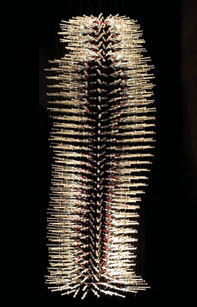
"Invisible Man" 2006
Commissioned by "Make
Art/Stop AIDS"
"In 1984 I became HIV positive." says artist Daniel Goldstein. "Because AIDS was literally a death sentence in the 1980's I realized that what I wanted to do with the rest of my life was to make sculpture, my first love as an artist." After the death of his life-partner in 1986, Goldstein committed himself completely to this task and since then he has created some of the most powerful pieces of art related to AIDS.
From mysterious human figures imprinted in leather to a sculpture of an invisible man, a recurrent theme in the works of the artist has been what he calls "the presence of the absence". "So many parts of my life had been lost along with those who had died. With the advent of antiretroviral treatment I had been brought back to life- but in a transformed state, a different body as it were in a very different world. I was partly present and hopeful and yet still living with so much absence."
In 2006 Goldstein started his collaboration with "Make Art/Stop AIDS", an initiative of the UCLA Art | Global Health Center consisting of an international network of scholars, artists and activists committed to ending the global AIDS epidemic. For this first collaboration, he created "Medicine Man" a human-shaped sculpture made out hundreds of his HIV medicine bottles.
His most recent sculpture is called "Invisible Man" and is made entirely of syringes. In this piece the figure's presence is made visible by its total absence. 864 syringes surround a human shaped void. The piece was also commissioned by "Make Art/Stop AIDS" to be exhibited at the International AIDS Conference in Vienna.
"Art is a powerful way to make AIDS emotionally, physically and spiritually real to people who have only known it before as an abstraction." says Goldstein. "For those living with HIV, art can also be a confirmation and acknowledgement of what we live with. It can offer both a catharsis and a celebration of the human experience in the face of incredible adversity."